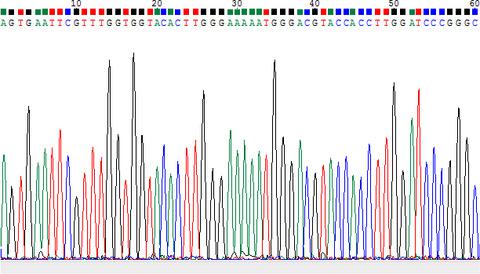当前位置:
X-MOL 学术
›
Lett. Appl. Microbiol.
›
论文详情
Our official English website, www.x-mol.net, welcomes your
feedback! (Note: you will need to create a separate account there.)
Detection of toxin B of Clostridium difficile based on immunomagnetic separation and aptamer‐mediated colorimetric assay
Letters in Applied Microbiology ( IF 2.0 ) Pub Date : 2020-10-02 , DOI: 10.1111/lam.13383 P Luo 1 , Y Liu 2
Letters in Applied Microbiology ( IF 2.0 ) Pub Date : 2020-10-02 , DOI: 10.1111/lam.13383 P Luo 1 , Y Liu 2
Affiliation

|
Clostridium difficile can cause antibiotic‐associated diarrhoea or pseudo‐membranous colitis in humans and animals. Currently, the various methods such as microbiological culture, cytotoxic assay, ELISA and polymerase chain reaction have been used to detect Clostridium difficile infection (CDI). These conventional methods, however, require long detection time and professional staff. The paper is to describe a simple strategy which employs immunomagnetic separation and aptamer‐mediated colorimetric assay for the detection of toxin B of C. difficile (TcdB) in the stool samples. HRP‐labelled aptamer against TcdB selected by SELEX was firstly captured on the surface of magnetic beads (MB) by DNA hybridization with a complementary strand. In the presence of TcdB, aptamer specifically recognized and bound TcdB, disturbing the DNA hybridization and causing the release of HRP‐aptamer from MB. This reduced the catalytic capacity of HRP and consequently the absorption intensity. As there was a relationship between the decrease in the absorption intensity and target concentration, a quantitative analysis of TcdB can be accomplished by the measurement of the absorption intensity. Under the optimal conditions, the assay system is able to detect TcdB at a concentration down to 5 ng ml−1. Moreover the method had specificity of 97% and sensitivity of 66% and the system remained excellent stability within 4 weeks. The proposed method is a valuable screening procedure for CDI and can be extended readily to detection of other clinically important pathogens.
中文翻译:

基于免疫磁性分离和适配体介导的比色法检测艰难梭菌毒素B
艰难梭菌可引起人类和动物的抗生素相关性腹泻或伪膜性结肠炎。目前,微生物培养、细胞毒性试验、ELISA和聚合酶链反应等多种方法已被用于检测艰难梭菌感染(CDI)。然而,这些传统方法需要较长的检测时间和专业人员。本文将描述一种简单的策略,该策略采用免疫磁性分离和适体介导的比色法检测粪便样本中的艰难梭菌毒素 B (TcdB)。由SELEX选择的针对TcdB的HRP标记适体首先通过与互补链的DNA杂交被捕获在磁珠(MB)的表面上。在 TcdB 存在下,适配体特异性识别并结合 TcdB,干扰 DNA 杂交并导致 HRP 适体从 MB 中释放。这降低了 HRP 的催化能力,从而降低了吸收强度。由于吸收强度的降低与目标浓度之间存在关系,因此可以通过测量吸收强度来实现TcdB的定量分析。在最佳条件下,分析系统能够检测低至 5 ng ml-1 的浓度的 TcdB。此外,该方法的特异性为 97%,灵敏度为 66%,系统在 4 周内保持良好的稳定性。所提出的方法是一种有价值的 CDI 筛查程序,可以很容易地扩展到其他临床重要病原体的检测。这降低了 HRP 的催化能力,从而降低了吸收强度。由于吸收强度的降低与目标浓度之间存在关系,因此可以通过测量吸收强度来实现TcdB的定量分析。在最佳条件下,分析系统能够检测低至 5 ng ml-1 的浓度的 TcdB。此外,该方法的特异性为 97%,灵敏度为 66%,系统在 4 周内保持良好的稳定性。所提出的方法是一种有价值的 CDI 筛查程序,可以很容易地扩展到其他临床上重要的病原体的检测。这降低了 HRP 的催化能力,从而降低了吸收强度。由于吸收强度的降低与目标浓度之间存在关系,因此可以通过测量吸收强度来实现TcdB的定量分析。在最佳条件下,分析系统能够检测低至 5 ng ml-1 的浓度的 TcdB。此外,该方法的特异性为 97%,灵敏度为 66%,系统在 4 周内保持良好的稳定性。所提出的方法是一种有价值的 CDI 筛查程序,可以很容易地扩展到其他临床上重要的病原体的检测。TcdB 的定量分析可以通过测量吸收强度来完成。在最佳条件下,分析系统能够检测低至 5 ng ml-1 的浓度的 TcdB。此外,该方法的特异性为 97%,灵敏度为 66%,系统在 4 周内保持良好的稳定性。所提出的方法是一种有价值的 CDI 筛查程序,可以很容易地扩展到其他临床上重要的病原体的检测。TcdB 的定量分析可以通过测量吸收强度来完成。在最佳条件下,分析系统能够检测低至 5 ng ml-1 的浓度的 TcdB。此外,该方法的特异性为 97%,灵敏度为 66%,系统在 4 周内保持良好的稳定性。所提出的方法是一种有价值的 CDI 筛查程序,可以很容易地扩展到其他临床上重要的病原体的检测。
更新日期:2020-10-02
中文翻译:

基于免疫磁性分离和适配体介导的比色法检测艰难梭菌毒素B
艰难梭菌可引起人类和动物的抗生素相关性腹泻或伪膜性结肠炎。目前,微生物培养、细胞毒性试验、ELISA和聚合酶链反应等多种方法已被用于检测艰难梭菌感染(CDI)。然而,这些传统方法需要较长的检测时间和专业人员。本文将描述一种简单的策略,该策略采用免疫磁性分离和适体介导的比色法检测粪便样本中的艰难梭菌毒素 B (TcdB)。由SELEX选择的针对TcdB的HRP标记适体首先通过与互补链的DNA杂交被捕获在磁珠(MB)的表面上。在 TcdB 存在下,适配体特异性识别并结合 TcdB,干扰 DNA 杂交并导致 HRP 适体从 MB 中释放。这降低了 HRP 的催化能力,从而降低了吸收强度。由于吸收强度的降低与目标浓度之间存在关系,因此可以通过测量吸收强度来实现TcdB的定量分析。在最佳条件下,分析系统能够检测低至 5 ng ml-1 的浓度的 TcdB。此外,该方法的特异性为 97%,灵敏度为 66%,系统在 4 周内保持良好的稳定性。所提出的方法是一种有价值的 CDI 筛查程序,可以很容易地扩展到其他临床重要病原体的检测。这降低了 HRP 的催化能力,从而降低了吸收强度。由于吸收强度的降低与目标浓度之间存在关系,因此可以通过测量吸收强度来实现TcdB的定量分析。在最佳条件下,分析系统能够检测低至 5 ng ml-1 的浓度的 TcdB。此外,该方法的特异性为 97%,灵敏度为 66%,系统在 4 周内保持良好的稳定性。所提出的方法是一种有价值的 CDI 筛查程序,可以很容易地扩展到其他临床上重要的病原体的检测。这降低了 HRP 的催化能力,从而降低了吸收强度。由于吸收强度的降低与目标浓度之间存在关系,因此可以通过测量吸收强度来实现TcdB的定量分析。在最佳条件下,分析系统能够检测低至 5 ng ml-1 的浓度的 TcdB。此外,该方法的特异性为 97%,灵敏度为 66%,系统在 4 周内保持良好的稳定性。所提出的方法是一种有价值的 CDI 筛查程序,可以很容易地扩展到其他临床上重要的病原体的检测。TcdB 的定量分析可以通过测量吸收强度来完成。在最佳条件下,分析系统能够检测低至 5 ng ml-1 的浓度的 TcdB。此外,该方法的特异性为 97%,灵敏度为 66%,系统在 4 周内保持良好的稳定性。所提出的方法是一种有价值的 CDI 筛查程序,可以很容易地扩展到其他临床上重要的病原体的检测。TcdB 的定量分析可以通过测量吸收强度来完成。在最佳条件下,分析系统能够检测低至 5 ng ml-1 的浓度的 TcdB。此外,该方法的特异性为 97%,灵敏度为 66%,系统在 4 周内保持良好的稳定性。所提出的方法是一种有价值的 CDI 筛查程序,可以很容易地扩展到其他临床上重要的病原体的检测。











































 京公网安备 11010802027423号
京公网安备 11010802027423号